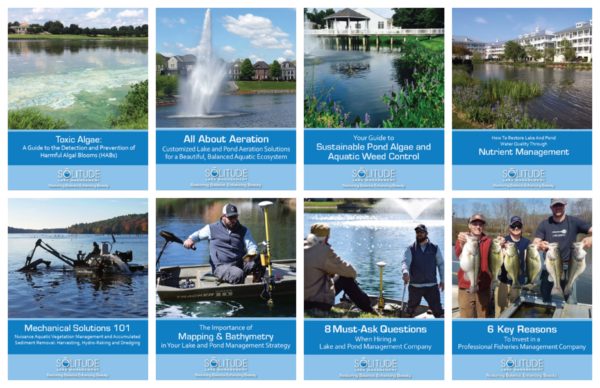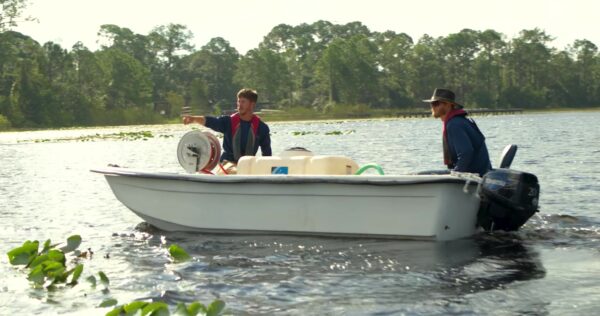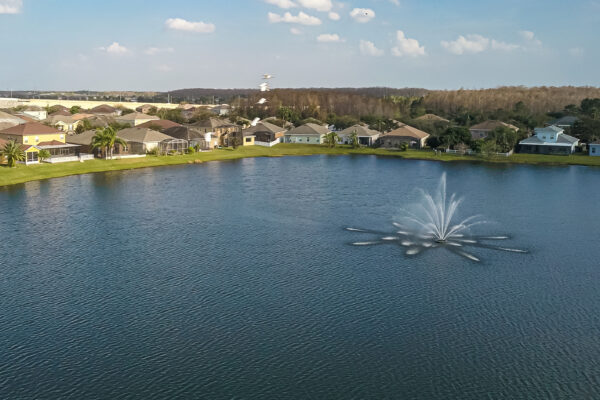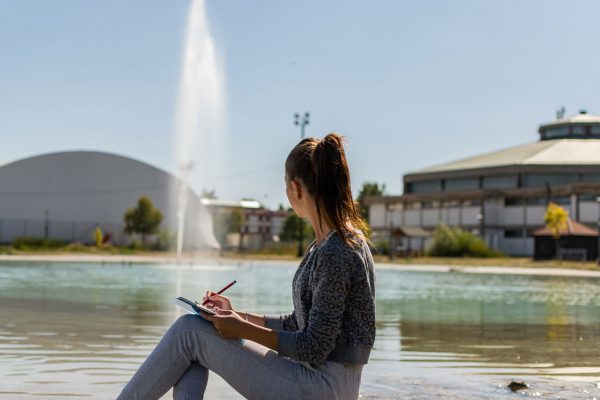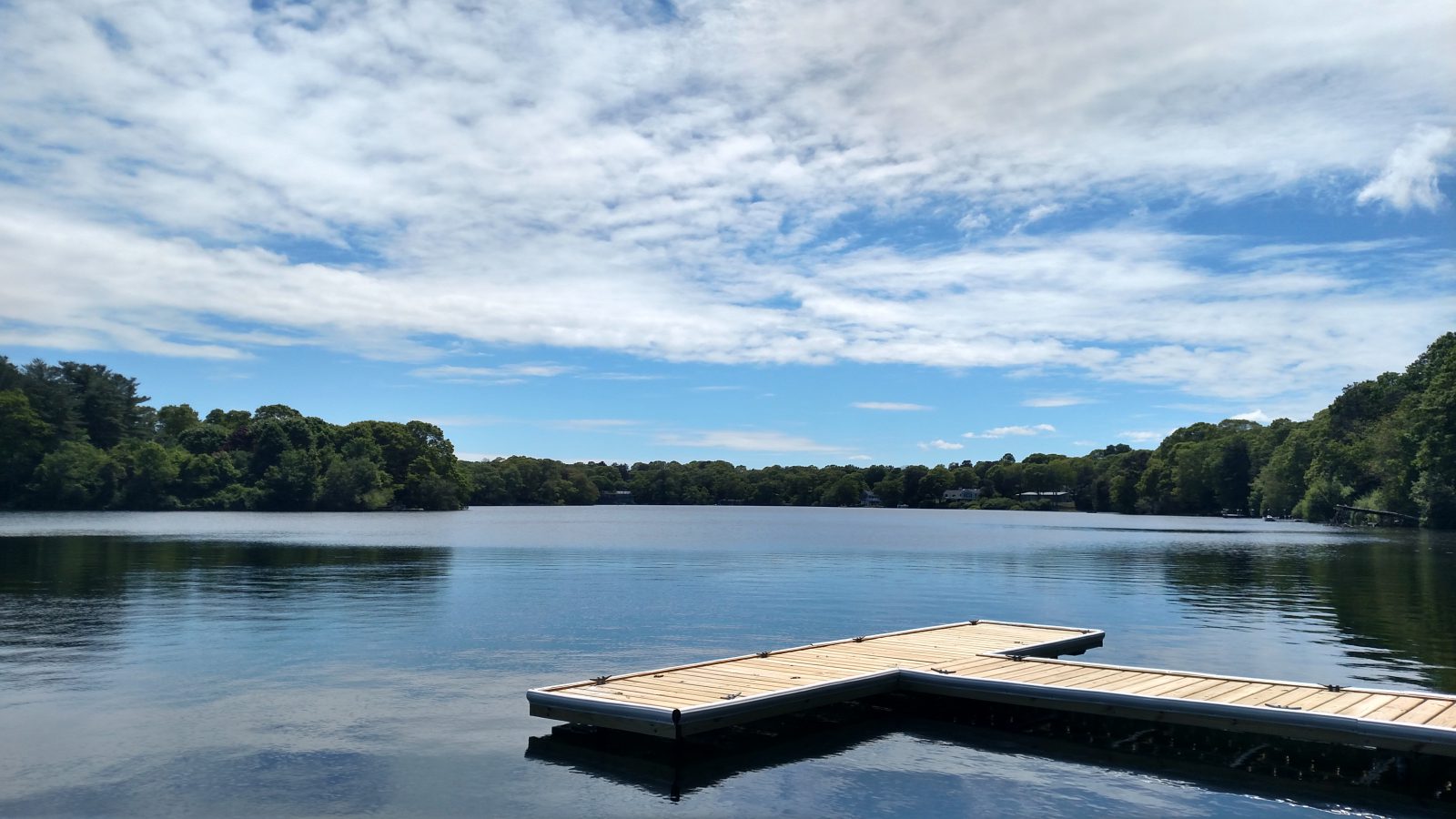

Site Description
Location and Acreage: St. Petersburg, FL
This property is a 14-acre lake located in St. Petersburg, on the western coast of Florida. In January 2012, the HOA contacted SOLitude Lake Management to request assistance with multiple lake issues including bad odors, dead fish and other wildlife, and green murky water. The following is a summary of the initial evaluation, execution of the management plan, and ecological restoration of the lake over an 11-month period.
Scope of Work
SOLitude conducted both field and lab tests to determine the existing chemical and biological conditions of the lake. Tests included levels of oxygen, redox, conductivity, pH, hydrogen sulfide, biochemical oxygen demand, salinity, turbidity, phosphorus, nitrogen, and chlorophyll. Our results showed that the lake was unsuitable for fish and other aquatic organisms; and posed a health risk to residents due to the intense noxious fumes being emitted from the lake. The main problems and the underlying causes identified were:
Intense Odors
Hydrogen sulfide (the source of the “rotten egg” odor) permeated the lake and surrounding area due to:
- Stratification
- The water never mixed enough to get dissolved oxygen (DO) to the lower levels where it was needed
- Large amounts of organic matter on the lake bottom-feeding bacteria
- As bacteria broke down organic matter, the available DO in the water was completely depleted
- Without oxygen, bacteria produce hydrogen sulfide as a byproduct
Fish Kills
A major fish kill that occurred in January 2012 was likely due to the rapid mixing of stratified layers in the water column caused by an existing aeration system installed by a previous lake management company. The system was undersized and installed only in the shallower areas. This undersized system was only strong enough to churn up water from the bottom of the lake without properly mixing and adding oxygen to the entire water column. This rapid mixing of bottom layer waters into the upper water levels depleted all the oxygen in the surface water and brought up high levels of hydrogen sulfide, methane, and ammonia from the bottom waters to the surface causing the death of fish, crabs, shrimp, snails and some birds in the lake.
Algal Blooms
The breakdown of large amounts of organic matter in the lower water column over time caused the buildup of high concentrations of nutrients, primarily phosphorus, and nitrogen. These high nutrient levels fed algal growth in the lake, which made the water look like “pea soup.”
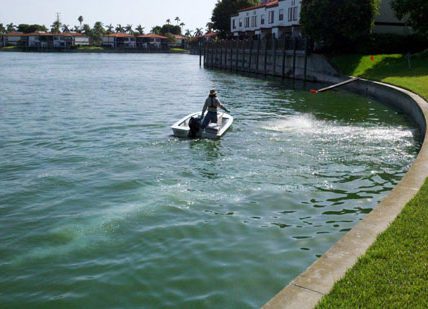
Project Description
Bathymetric Mapping
SOLitude was informed that the lake was only 18ft at its deepest point. To confirm this, we conducted bathymetric mapping which allowed us to determine accurate depths throughout the lake, the total water volume, and the location of vegetation in the lake. Mapping showed areas within the lake that were actually over 50’ deep. This information allowed us to determine exactly how much aeration was needed to circulate the entire water body each day and to identify the best locations in the lake for placement of the aeration.
All preliminary results indicated that this lake system was extremely unhealthy. We determined that a multi-faceted treatment approach designed to target the main underlying issues in the lake was needed. To ensure optimal results, we implemented one step at a time and continued monitoring and testing to document the lake’s improvement.
Submersed Aeration
A much larger customized submersed aeration system was installed in the lake to effectively circulate the water in the lake thereby:
- Removing stratification and allowing the entire waterbody to mix.
- Increasing oxygen uptake and distribution throughout the water column.
- Speeding up the removal of toxic hydrogen sulfide and methane gasses.
- Encouraging the breakdown of organic materials in the bottom of the lake.
- Reducing nutrient levels by:
- Creating an aerobic layer above the sediment allowed phosphorus to remain bound to minerals such as iron and manganese within the sediment, and reduced its leaching back into the lake.
- Providing oxygen promoted the transformation of toxic ammonia to other forms of nitrogen.
Alum Application
Algal blooms were being fueled by the high levels of nutrients in the water column. To quickly and effectively reduce the nutrient levels we decided to treat the lake with Alum (aluminum sulfate), a well-known flocking agent that binds to suspended matter (including fine suspended silt, clay, and organic matter, phytoplankton, and bacteria) and nutrients within the water column and then sinks to the bottom of the lake, thus clearing the water column. Alum has been shown in multiple studies to significantly improve lake water quality and clarity.
Laboratory trials showed that due to the extremely high phosphorus levels in the lake, two separate Alum treatments were needed to reduce the lake phosphorus concentration to an acceptable level.
The treatment created clearer water that allowed greater light penetration throughout the water column. It also removed phosphorus and nitrogen from the water column and held those nutrients in the sediment layer where they become unavailable for uptake by organisms.
Water Quality Monitoring
During and after the implementation of our lake management plan, we continued monthly monitoring of the lake in order to determine how well the treatment program was working and whether or not any additional treatment options needed to be considered. Water quality monitoring included measurements of Oxygen, Redox, Conductivity, pH, Hydrogen sulfide, Biochemical oxygen demand, Salinity, Turbidity, Phosphorus, Nitrogen, and Chlorophyll a, as well as visual assessments of aquatic life (e.g. fish presence).
Results
Over the 11-month period during which we worked on and monitored the Florida Community Lake, it went from a smelly, murky body of water, with no aquatic life to an odor-free, clear water body, teeming with fish, crabs, and shrimp. The lake is now healthy and vibrant. Notably—
- Oxygen is now found at all levels throughout the water column
- Oxygen at bottom of the lake went from 0 mg/L to 8 mg/L
- BOD at the bottom of the lake went from 385 mg/L to 2.5 mg/L: a 99% reduction
- “Rotten Egg” odor was eliminated: hydrogen sulfide levels went from >5 mg/L to 0 mg/L
- Water clarity improved
- Turbidity went from 113 NTU to 8 NTU: a 92% reduction
- Chlorophyll concentrations went from 87 μg/L to 24 μg/L: a 72% reduction
- Nutrient levels reduced
- Bottom water Phosphate went from 8137 μg/L to 35 μg/L: a 99% reduction
- Bottom water Nitrogen Ammonia went from 109,250 μg/L to 800 μg/L: a 99% reduction
Oxygen
Prior to aeration installation the water was stratified, with very high oxygen levels (12 to 15 mg/L) at the surface and little to no oxygen (0 to 1 mg/L) in deeper waters. This is often seen in lakes with algal blooms, where the high surface oxygen levels reflect the oxygen-producing activity of large quantities of photosynthesizing phytoplankton in the surface waters. Although oxygen at the surface is high during the day, at night, oxygen consumption by the same plankton would decrease oxygen levels, creating stressful conditions for fish and other aquatic life.
After a submersed aeration system was installed in the lake, stratification was eliminated and the water mixed evenly, but oxygen levels were very low (< 1mg/L). However, after 9 months of continuous aeration, the oxygen levels throughout the water column remained around 8mg/L (even at a depth of 50ft), which is better than what would be expected in a healthy lake system
Hydrogen Sulfide (rotten egg odor)
Hydrogen sulfide is produced as a byproduct of anaerobic respiration, i.e.respiration in the absence of oxygen, and is the gas responsible for the “rotten egg” odor that permeated the property adjacent to the lake. The addition of aeration to the lake helped to eliminate the large amounts of hydrogen sulfide gas by:
- Circulating the water efficiently enough to bring bottom water up to the surface, where hydrogen sulfide could then diffuse out of the water into the atmosphere.
- Carrying oxygenated surface water down to the bottom of the lake and thereby providing enough oxygen to promote aerobic respiration and stop the production of hydrogen sulfide which can only result from anaerobic respiration.
Hydrogen sulfide concentrations began to decrease following the installation of Vertex aeration and the gas was completely undetectable in the water after 10weeks of continuous aeration and has not been detected since that time.
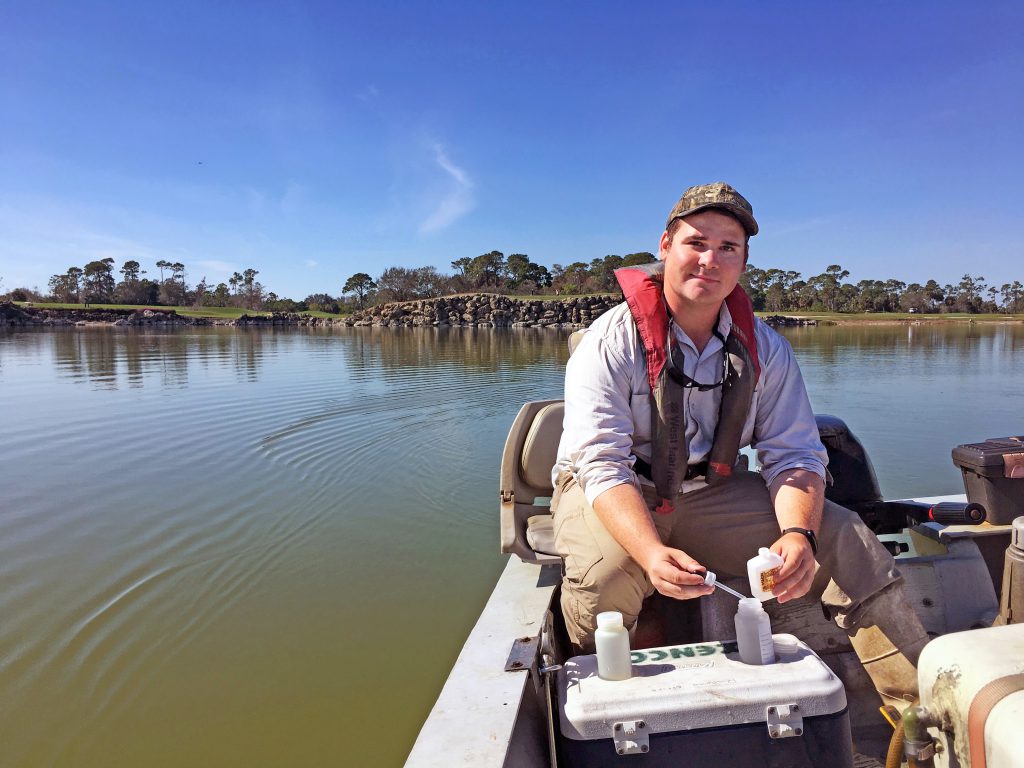
Biochemical Oxygen Demand
Biochemical oxygen demand (BOD) is a measure of the amount of oxygen needed by organisms in a body of water to break down the organic matter in that body of water.
- If there is very little organic matter to be broken down, BOD (oxygen consumption) will be low, and the oxygen available in the water will not be used up, creating healthy conditions for fish and other aquatic life.
- If there is a lot of organic matter to be broken down, BOD (oxygen consumption) will be high, and the oxygen available in the water can be quickly used up creating unhealthy conditions for fish and aquatic life.
Initially, BOD levels were similar to what might be observed in a sewage treatment plant (> 350 mg/L), meaning there was a large amount of organic matter in the lower water column and all the available oxygen had already been used up, which is why oxygen levels were so low. After the installation of the submersed aeration system, the BOD decreased markedly over time and is currently at or near 2mg/L, which is what would be desired in a healthy lake system.
Turbidity
Turbidity refers to the presence of suspended solids in water. These suspended solids can be inorganic (e.g. silt, clay) or organic (e.g. plankton and other microscopic organisms, detrital material). The turbidity test measures an optical property of the water sample and is used as an index of water clarity. Turbidity values of 10 N.T.U.’s (Nephelometric Turbidity Units) or more indicate high levels of suspended solids.
The community initially had highly elevated turbidity levels, especially in the lower water column, mainly due to large amounts of plankton and suspended detrital materials in the water column. Following the installation of Vertexaeration turbidity levels were reduced to around 20 NTU and after the twoAlum treatments, levels were further reduced and now consistently remain below 15 NTU. Levels are still slightly elevated due to the presence of some phytoplankton in the water column.
Chlorophyll
Chlorophyll is the main pigment found in algae. Therefore, measuring the amount of chlorophyll within the water provides an estimate of how much algae is in the water. Bahia del Mar initially had extremely high chlorophyll levels (i.e. large amounts of planktonic algae), giving the water a green-brown“pea soup” appearance. The high abundance of planktonic algae was directly due to the large amount of nutrients (phosphorus and nitrogen) in the water, which serve as food for algae.
Following the installation of lake aeration and the initial stirring up of nutrients from the bottom of the lake, phytoplankton abundance increased. However, as nutrient levels in the water declined in response to continued aeration and the subsequent alum treatments, chlorophyll concentrations were reduced from >700 μg/L to < 50 μg/L, resulting in clearer water and a change in the color of the water.
Nutrients
The lake had been subjected to several years of fish kills, debris falling into the lake, and plankton blooms and die-offs, all of which contribute to the buildup of organic matter bottom sediments. As this organic material was broken down by bacteria, nutrients were released into the water column, and therefore over time extremely high levels of phosphorus and nitrogen built up in the water body, resulting in nutrient levels similar to what might be seen in a sewage treatment system!
Phosphorus
Oxygen promotes the binding of phosphorus to minerals such as iron and manganese, and once bound within the sediment, phosphorus is effectively kept out of the water column. Therefore, following the installation of Vertexaeration, although phosphorus levels initially increased after the water was first mixed, there was a subsequent decrease over time, from > 8000 μg/L to ~3000μg/L. After the two subsequent Alum treatments, levels were further reduced and now consistently remain below 60 μg/L, which is well within the desired range for this lake.
Nitrogen
Oxygen promotes the conversion of ammonia to non-toxic forms of nitrogen and also facilitates the removal of nitrogen from the water as a gas. Following the installation of Vertex aeration nitrogen levels were reduced from > 100,000μg/L to 800 μg/L. After the two Alum treatments, levels were further reduced and now fluctuate between 600 and 900 μg/L, with the fluctuation being due mainly to excrement from fish feeding on plankton in the water column and possibly runoff of fertilizers applied to adjacent lawns.
Over the course of 11 months, SOLitude was successful in addressing the multiple lake issues that plagued the HOA waterbody. The murky water and bad odors were reversed through carefully implemented nutrient remediation solutions, aeration equipment, and close water quality monitoring. These sustainable measures simultaneously helped prevent fish kills and the growth of undesirable plants and algae. Now, the community is in a position to continue proactive management strategies, rather than address issues after they have already become a nuisance.



